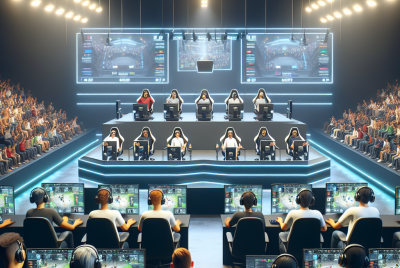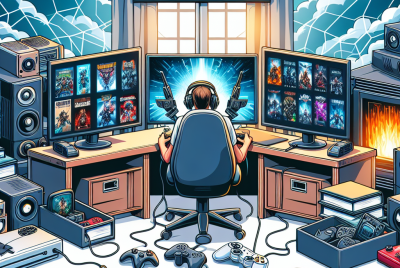Must-Have Equipment for Your VR Gaming Setup
Understanding VR Equipment Basics
What is VR Gaming?
Virtual Reality (VR) gaming immerses players in a fully interactive digital environment. Unlike traditional gaming, where players interact with a screen, VR allows for a three-dimensional experience, making you feel as though you are truly inside the game.
The Importance of the Right Equipment
Having the right equipment can drastically change your VR gaming experience. High-quality gear enhances immersion, comfort, and performance.
The Must-Have Gear for Your VR Setup
Headsets
Types of VR Headsets
There are various types of VR headsets available in the market, catering to different preferences and budgets.
Standalone VR Headsets
These headsets operate independently without needing a computer or console. Popular examples include the Oculus Quest 2 and Pico 4. They are portable and user-friendly, ideal for casual gamers and newcomers to VR.
Tethered VR Headsets
Tethered headsets, like the HTC Vive Pro and Valve Index, require a powerful gaming PC. They provide superior graphics and tracking, making them a favorite for serious gamers seeking the best experience.
Mobile VR Headsets
These are compatible with smartphones and are less immersive than standalone or tethered headsets. Models such as Samsung Gear VR and Google Daydream fall under this category.
Comfort and Fit
A well-fitting headset is vital for comfort during long sessions. Look for one with adjustable straps and adequate padding. Consider the weight of the headset as well, as a heavy model may strain your neck over time.
Controllers
Importance of Controllers
Controllers serve as your hands in the virtual world. They are essential for interaction, navigation, and gameplay mechanics.
Types of VR Controllers
Different VR systems have various types of controllers:
Motion Controllers
These controllers are designed to track your hand movements accurately, allowing for natural interactions with the VR environment. The Oculus Touch and Valve Index controllers are prime examples.
Gamepads
Some VR systems also allow traditional gamepads for gaming. Devices like the Xbox controller are compatible with many VR games, providing an alternative for those who prefer standard controls.
Ergonomics of Controllers
The controller should fit comfortably in your hand and be easy to operate. Consider the button layout and ensure you can access all features without straining.
Tracking Systems
Understanding Tracking in VR
Tracking involves capturing the position and movement of your headset and controllers to reflect them accurately in the virtual space.
Types of Tracking Systems
There are generally two kinds of tracking systems:
Inside-Out Tracking
Common in standalone headsets, inside-out tracking uses built-in cameras on the headset to understand your surroundings and track your movements. It’s convenient and easy to set up.
Outside-In Tracking
This system relies on external sensors placed around your play area. The HTC Vive and Valve Index utilize this method, often providing greater accuracy but requiring more setup.
Audio Equipment
Immersive Sound Experience
Sound is crucial in VR, as it helps create a believable environment. Quality audio equipment can greatly enhance immersion.
Built-in versus External Audio
Most VR headsets come with integrated audio, which can be sufficient. However, investing in high-quality external headphones can provide a richer sound experience.
Types of Headphones
Choose from various headphones such as over-ear, on-ear, or in-ear. Over-ear headphones generally offer better sound isolation, while on-ear headphones are often lighter.
Surround Sound Technology
For the most immersive experience, consider headphones with surround sound capabilities. They provide spatial audio, allowing you to hear sounds coming from various directions, mimicking real-life experiences.
VR-capable PC or Console
The Heart of Your VR Setup
Having the right gaming PC or console is essential if you opt for tethered VR. It determines the quality of the graphics and frame rates you can achieve in VR.
PC Specifications
To run most VR games smoothly, your PC will need specific hardware requirements:
Graphics Card
A powerful GPU is crucial for rendering VR environments. Consider options like NVIDIA’s GeForce RTX 30 series or AMD’s Radeon RX 6000 series for optimal performance.
Processor
A robust CPU, such as the Intel i5 or Ryzen 5 line, will help manage tasks like input processing and game physics efficiently.
RAM and Storage
At least 16GB of RAM is recommended for smooth VR experiences. For storage, a fast SSD can significantly reduce loading times.
Console Options
If you’re inclined towards console gaming, platforms like PlayStation 5 support VR headsets like the PlayStation VR. Make sure your console meets the VR game’s requirements.
VR Space and Accessories
Creating a Dedicated VR Space
Setting up a dedicated play area greatly improves your VR experience. Ensure enough space for movement, with a minimum of 6.5 feet by 6.5 feet for room-scale experiences.
Safety Measures
Make sure to remove any obstacles in your play area to avoid accidents. Consider using safety mats or markers on the floor to define your boundaries visually.
VR Accessories
Enhance your VR experience with various accessories:
VR Covers
These are removable and wash-friendly covers that improve hygiene and comfort. They can help absorb sweat during intense gaming sessions.
Cleansing Kits
Keep your lenses and headset clean with dedicated cleaning kits that won’t damage the delicate materials.
Link Cables
If using a tethered headset, a high-quality link cable can prevent lag and disconnects, ensuring a smooth gaming experience.
Additional Enhancements
VR Gun and Motion Accessories
For added immersion in specific games, consider controllers designed for specific game genres, such as gun stocks for shooting games or steering wheels for racing games.
Virtual Reality Treadmills
For the ultimate immersion, VR treadmills allow you to walk or run in the virtual space, blending physical movement with in-game actions.
Social VR and Streaming Gear
VR allows you to connect with friends in virtual environments. Having a good microphone and webcam can enhance social interactions and streaming experiences.
Conclusion
While the world of VR gaming can seem overwhelming with the variety of equipment available, focusing on your specific needs and preferences will help create a fantastic gaming experience. Take into account the quality of the headset, controllers, tracking systems, and audio equipment to ensure a seamless transition into the immersive world of virtual reality.




